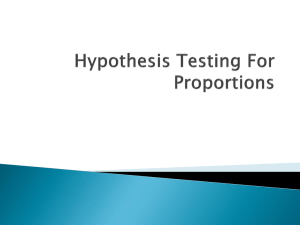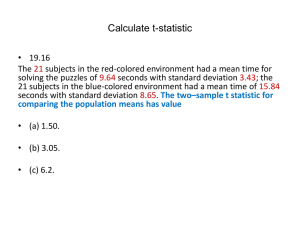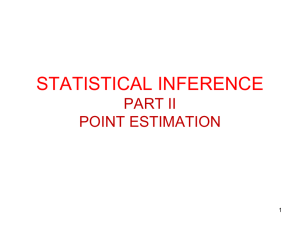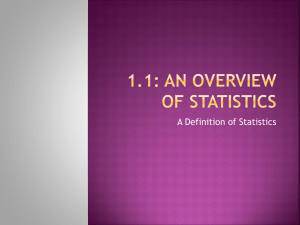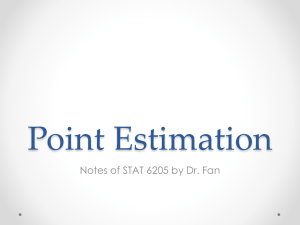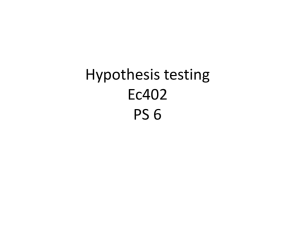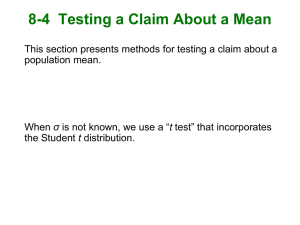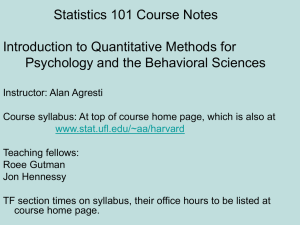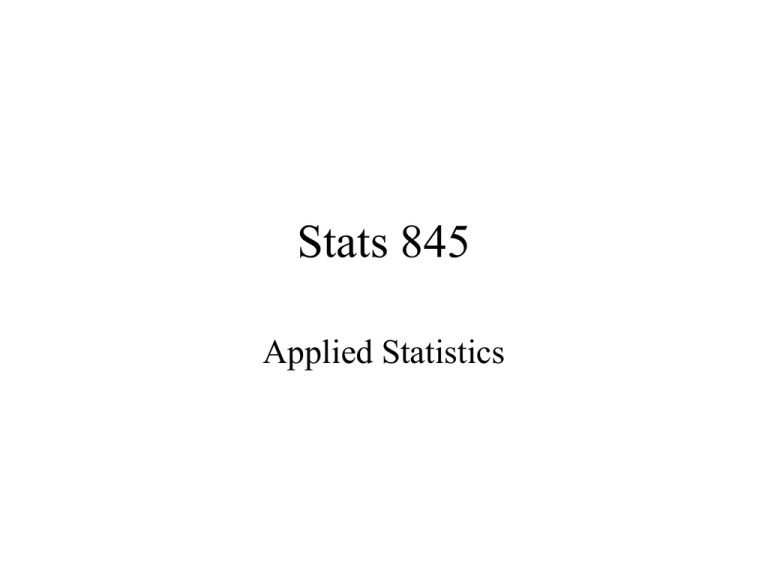
Stats 845
Applied Statistics
This Course will cover:
1. Regression
–
–
Non Linear Regression
Multiple Regression
2. Analysis of Variance and Experimental
Design
The Emphasis will be on:
1. Learning Techniques through example:
2. Use of common statistical packages.
•
•
•
•
SPSS
Minitab
SAS
SPlus
What is Statistics?
It is the major mathematical tool of
scientific inference - the art of drawing
conclusion from data. Data that is to some
extent corrupted by some component of
random variation (random noise)
An analogy can be drawn to
data that is affected by
random components of
variation to signals that are
corrupted by noise.
Quite often sounds that are
heard or received by some
radio receiver can be thought
of as signals with
superimposed noise.
The objective in signal theory
is to extract the signal from
the received sound (i.e.
remove the noise to the
greatest extent possible). The
same is true in data analysis.
Example A:
Suppose we are comparing
the effect of three different
diets on weight loss.
An observation on weight loss
can be thought of as being
made up of two components:
1. A component due to the effect
of the diet being applied to the
subject (the signal)
2. A random component due to
other factors affecting weight
loss not considered (initial
weight of the subject, sex of the
subject, metabolic makeup of
the subject.) random noise.
Note:
that random assignment of
subjects to diets will ensure
that this component will be a
random effect.
Example B
In this example we again are
comparing the effect of three diets on weight
gain. Subjects are randomly divided into three
groups. Diets are randomly distributed
amongst the groups. Measurements on weight
gain are taken at the following times - one month
- two months
- 6 months and
- 1 year
after commencement of the diet.
In addition to both the factors Time and Diet
effecting weight gain there are two random
sources of variation (noise)
- between subject variation and
- within subject variation
This can be illustrated in a schematic
fashion as follows:
Deterministic factors
Diet
Time
Random Noise
within subject
between subject
Response
weight gain
The circle of Research
Questions arise about
a phenomenon
A decision is made to
collect data
Conclusion are drawn
from the analysis
Statistics
Statistics
A decision is made as
how to collect the
data
The data is
summarized and
analyzed
The data is collected
Notice the two points on the
circle where statistics plays
an important role:
1.The analysis of the collected data.
2.The design of a data collection
procedure
The analysis of the collected
data.
• This of course is the traditional use of statistics.
• Note that if the data collection procedure is well
thought out and well designed, the analysis step of
the research project will be straightforward.
• Usually experimental designs are chosen with the
statistical analysis already in mind.
• Thus the strategy for the analysis is usually
decided upon when any study is designed.
• It is a dangerous practice to select the form
of analysis after the data has been collected
( the choice may to favour certain predetermined conclusions and therefore in a
considerable loss in objectivity )
• Sometimes however a decision to use a
specific type of analysis has to be made
after the data has been collected (It was
overlooked at the design stage)
The design of a data collection
procedure
• the importance of statistics is quite
often ignored at this stage.
• It is important that the data collection
procedure will eventually result in
answers to the research questions.
• And will result in the most
accurate answers for the resources
available to research team.
• Note the success of a research
project should not depend on the
answers that it comes up with but
the accuracy of the answers.
• This fact is usually an indicator of
a valuable research project..
Some definitions
important to Statistics
A population:
this is the complete collection of subjects
(objects) that are of interest in the study.
There may be (and frequently are) more
than one in which case a major objective
is that of comparison.
A case (elementary sampling
unit):
This is an individual unit (subject) of the
population.
A variable:
a measurement or type of measurement
that is made on each individual case in the
population.
Types of variables
Some variables may be measured on a
numerical scale while others are
measured on a categorical scale.
The nature of the variables has a great
influence on which analysis will be used. .
For Variables measured on a numerical scale
the measurements will be numbers.
Ex: Age, Weight, Systolic Blood Pressure
For Variables measured on a categorical scale
the measurements will be categories.
Ex: Sex, Religion, Heart Disease
Types of variables
In addition some variables are labeled as
dependent variables and some variables
are labeled as independent variables.
This usually depends on the objectives of
the analysis.
Dependent variables are output or
response variables while the
independent variables are the input
variables or factors.
Usually one is interested in determining
equations that describe how the dependent
variables are affected by the independent
variables
A sample:
Is a subset of the population
Types of Samples
different types of samples are determined
by how the sample is selected.
Convenience Samples
In a convenience sample the subjects that
are most convenient to the researcher are
selected as objects in the sample.
This is not a very good procedure for
inferential Statistical Analysis but is
useful for exploratory preliminary work.
Quota samples
In quota samples subjects are chosen
conveniently until quotas are met for
different subgroups of the population.
This also is useful for exploratory
preliminary work.
Random Samples
Random samples of a given size are
selected in such that all possible samples
of that size have the same probability of
being selected.
Convenience Samples and Quota samples
are useful for preliminary studies. It is
however difficult to assess the accuracy
of estimates based on this type of
sampling scheme.
Sometimes however one has to be
satisfied with a convenience sample and
assume that it is equivalent to a random
sampling procedure
A population statistic
(parameter):
Any quantity computed from the values
of variables for the entire population.
A sample statistic:
Any quantity computed from the values
of variables for the cases in the sample.
Statistical Decision Making
• Almost all problems in statistics
can be formulated as a problem of
making a decision .
• That is given some data observed
from some phenomena, a decision
will have to be made about the
phenomena
Decisions are generally broken
into two types:
• Estimation decisions
and
• Hypothesis Testing decisions.
Probability Theory plays a very
important role in these decisions
and the assessment of error made
by these decisions
Definition:
A random variable X is a
numerical quantity that is
determined by the outcome of a
random experiment
Example :
An individual is selected at
random from a population
and
X = the weight of the individual
The probability distribution of a
random variable (continuous) is
describe by:
its probability density curve f(x).
i.e. a curve which has the
following properties :
• 1. f(x) is always positive.
• 2. The total are under the curve f(x) is
one.
• 3. The area under the curve f(x) between
a and b is the probability that X lies
between the two values.
0.025
0.02
0.015
f(x)
0.01
0.005
0
0
20
40
60
80
100
120
Examples of some important
Univariate distributions
1.The Normal distribution
A common probability density curve is the “Normal”
density curve - symmetric and bell shaped
Comment: If m = 0 and s = 1 the distribution is
called the standard normal distribution
0.03
Normal distribution
with m = 50 and s =15
0.025
0.02
Normal distribution with
m = 70 and s =20
0.015
0.01
0.005
0
0
20
40
60
80
100
120
xm
2
1
f(x)
e
2s
2s
2
2.The Chi-squared distribution
with n degrees of freedom
1
(n 2 ) / 2 x / 2
f ( x) n n / 2 x
e if x 0
2 2
0.5
0.4
0.3
0.2
0.1
2
4
6
8
10
12 14
Comment: If z1, z2, ..., zn are
independent random variables each
having a standard normal distribution
then
2
2
2
U = z1 z2 zn
has a chi-squared distribution with n
degrees of freedom.
3. The F distribution with
n1 degrees of freedom in the
numerator and n2 degrees of
freedom in the denominator
n1 n2 / 2
n1
if x 0
1 x
f(x) K x
n 2
n1 / 2
n1
n1 n 2
n
2
2
where K =
n1 n2
2 2
(n1 2)2
0.8
0.7
0.6
F dist
0.5
0.4
0.3
0.2
0.1
0
0
1
2
3
4
5
6
Comment: If U1 and U2 are independent
random variables each having Chi-squared
distribution with n1 and n2 degrees of
freedom respectively then
U1 n1
F=
U 2 n2
has a F distribution with n1 degrees of
freedom in the numerator and n2 degrees of
freedom in the denominator
4.The t distribution with n
degrees of freedom
n1 / 2
x
f(x) K 1
n
2
n 1
2
where K =
n
n
2
0.4
0.3
0.2
0.1
-4
-2
2
4
Comment: If z and U are independent
random variables, and z has a standard
Normal distribution while U has a Chisquared distribution with n degrees of
freedom then
t=
z
U n
has a t distribution with n degrees of
freedom.
•
1.
2.
3.
4.
5.
An Applet showing critical values and tail
probabilities for various distributions
Standard Normal
T distribution
Chi-square distribution
Gamma distribution
F distribution
The Sampling distribution
of a statistic
A random sample from a probability
distribution, with density function
f(x) is a collection of n independent
random variables, x1, x2, ...,xn with a
probability distribution described by
f(x).
If for example we collect a random
sample of individuals from a population
and
– measure some variable X for each of
those individuals,
– the n measurements x1, x2, ...,xn will
form a set of n independent random
variables with a probability distribution
equivalent to the distribution of X across
the population.
A statistic T is any quantity
computed from the random
observations x1, x2, ...,xn.
• Any statistic will necessarily be
also a random variable and
therefore will have a probability
distribution described by some
probability density function fT(t).
• This distribution is called the
sampling distribution of the
statistic T.
• This distribution is very important if one is
using this statistic in a statistical analysis.
• It is used to assess the accuracy of a
statistic if it is used as an estimator.
• It is used to determine thresholds for
acceptance and rejection if it is used for
Hypothesis testing.
Some examples of Sampling
distributions of statistics
Distribution of the sample mean for a
sample from a Normal popululation
Let x1, x2, ...,xn is a sample from a normal
population with mean m and standard
deviation s
Let
x
x
i
i
n
Than
x
x
i
i
n
has a normal sampling distribution with mean
mx m
and standard deviation
sx s
n
0
20
40
60
80
100
Distribution of the z statistic
Let x1, x2, ...,xn is a sample from a normal
population with mean m and standard deviation s
Let
z
xm
s
n
Then z has a standard normal distibution
Comment:
Many statistics T have a normal distribution
with mean mT and standard deviation sT.
Then
T mT
z
sT
will have a standard normal distribution.
Distribution of the c2 statistic for
sample variance
Let x1, x2, ...,xn is a sample from a normal
population with mean m and standard deviation s
Let
s2
and
2
x
x
i
i
n 1
= sample variance
xi x
2
s
i
n 1
= sample standard deviation
Let
c
2
x
i
x
2
i
s
2
(n 1)s
s2
2
Then c2 has chi-squared distribution with n
= n-1 degrees of freedom.
The chi-squared
distribution
0 .5
0
0
4
8
12
16
20
24
Distribution of the t statistic
Let x1, x2, ...,xn is a sample from a normal
population with mean m and standard deviation s
Let
xm
t s
n
then t has student’s t distribution with n = n-1
degrees of freedom
Comment:
If an estimator T has a normal distribution with
mean mT and standard deviation sT.
If sT is an estimatior of sT based on n degrees of
freedom
Then
TmT
t
sT
will have student’s t distribution with n degrees of
freedom. .
t distribution
standard normal distribution
Point estimation
• A statistic T is called an estimator of the
parameter q if its value is used as an
estimate of the parameter q.
• The performance of an estimator T will be
determined by how “close” the sampling
distribution of T is to the parameter, q,
being estimated.
• An estimator T is called an unbiased
estimator of q if mT, the mean of the
sampling distribution of T satisfies mT = q.
• This implies that in the long run the average
value of T is q.
• An estimator T is called the Minimum
Variance Unbiased estimator of q if T is an
unbiased estimator and it has the smallest
standard error sT amongst all unbiased
estimators of q.
• If the sampling distribution of T is normal,
the standard error of T is extremely
important. It completely describes the
variability of the estimator T.
Interval Estimation
(confidence intervals)
• Point estimators give only single values as
an estimate. There is no indication of the
accuracy of the estimate.
• The accuracy can sometimes be measured
and shown by displaying the standard error
of the estimate.
• There is however a better way.
• Using the idea of confidence interval
estimates
• The unknown parameter is estimated with a
range of values that have a given probability
of capturing the parameter being estimated.
Confidence Intervals
• The interval TL to TU is called a (1 - a)
100 % confidence interval for the parameter
q, if the probability that q lies in the range
TL to TU is equal to 1 - a.
• Here , TL to TU , are
– statistics
– random numerical quantities calculated from
the data.
Examples
Confidence interval for the mean of a Normal population
(based on the z statistic).
TL x za / 2
s
s
t o TU x za / 2
n
n
is a (1 - a) 100 % confidence interval for m, the mean of a
normal population.
Here za/2 is the upper a/2 100 % percentage point of the
standard normal distribution.
More generally if T is an unbiased estimator of the parameter
q and has a normal sampling distribution with known
standard error sT then
TL T z a / 2 s T to TU T z a / 2 s T
is a (1 - a) 100 % confidence interval for q.
Confidence interval for the mean of a Normal
population
(based on the t statistic).
TL x t a / 2
s
s
t o TU x t a / 2
n
n
is a (1 - a) 100 % confidence interval for m, the
mean of a normal population.
Here ta/2 is the upper a/2 100 % percentage point
of the Student’s t distribution with n = n-1 degrees of
freedom.
More generally if T is an unbiased estimator of the parameter
q and has a normal sampling distribution with estmated
standard error sT, based on n degrees of freedom, then
TL T t a / 2 s T to TU T t a / 2 s T
is a (1 - a) 100 % confidence interval for q.
Common Confidence intervals
Situation
Sample form the Normal distribution with unknown
mean and known variance
(Estimating m) (n large)
Sample form the Normal distribution with unknown
mean and unknown variance (Estimating m)(n small)
Confidence interval
x za / 2
x ta / 2
Estimation of a binomial probability p
pˆ za / 2
Two independent samples from the Normal
distribution with unknown means and known
variances
(Estimating m1 - m2) (n,m large)
Two independent samples from the Normal
distribution with unknown means and unknown but
equal variances. (Estimating m1 - m2) ) (n,m small)
Estimation of a the difference between two binomial
probabilities, p1-p2
s0
n
s
n
pˆ (1 pˆ )
n
x y za / 2
2
s x2 s y
n m
x y ta / 2 s Pooled
pˆ 1 pˆ 2 za / 2
1 1
n m
pˆ 1 (1 pˆ 1 ) pˆ 2 (1 pˆ 2 )
n1
n2
Multiple Confidence intervals
In many situations one is interested in estimating not
only a single parameter, q, but a collection of
parameters, q1, q2, q3, ... .
A collection of intervals, TL1 to TU1, TL2 to TU2, TL3
to TU3, ... are called a set of (1 - a) 100 % multiple
confidence intervals if the probability that all the
intervals capture their respective parameters is 1 - a
Hypothesis Testing
• Another important area of statistical
inference is that of Hypothesis Testing.
• In this situation one has a statement
(Hypothesis) about the parameter(s) of the
distributions being sampled and one is
interested in deciding whether the statement
is true or false.
• In fact there are two hypotheses
– The Null Hypothesis (H0) and
– the Alternative Hypothesis (HA).
• A decision will be made either to
– Accept H0 (Reject HA) or to
– Reject H0 (Accept HA). The following table
gives the different possibilities for the decision
and the different possibilities for the correctness
of the decision
• The following table gives the different
possibilities for the decision and the
different possibilities for the correctness of
the decision
H0
is true
H0
is false
Accept H0
Reject H0
Correct
Decision
Type II
error
Type I
error
Correct
Decision
• Type I error - The Null Hypothesis H0 is
rejected when it is true.
• The probability that a decision procedure
makes a type I error is denoted by a, and is
sometimes called the significance level of
the test.
• Common significance levels that are used
are a = .05 and a = .01
• Type II error - The Null Hypothesis H0 is
accepted when it is false.
• The probability that a decision procedure
makes a type II error is denoted by b.
• The probability 1 - b is called the Power of
the test and is the probability that the
decision procedure correctly rejects a false
Null Hypothesis.
A statistical test is defined by
• 1. Choosing a statistic for making the
decision to Accept or Reject H0. This
statisitic is called the test statistic.
• 2. Dividing the set of possible values of
the test statistic into two regions - an
Acceptance and Critical Region.
• If upon collection of the data and evaluation
of the test statistic, its value lies in the
Acceptance Region, a decision is made to
accept the Null Hypothesis H0.
• If upon collection of the data and evaluation
of the test statistic, its value lies in the
Critical Region, a decision is made to reject
the Null Hypothesis H0.
• The probability of a type I error, a, is
usually set at a predefined level by choosing
the critical thresholds (boundaries between
the Acceptance and Critical Regions)
appropriately.
• The probability of a type II error, b, is
decreased (and the power of the test, 1 - b,
is increased) by
1. Choosing the “best” test statistic.
2. Selecting the most efficient experimental
design.
3. Increasing the amount of information
(usually by increasing the sample sizes
involved) that the decision is based.
Some common Tests
Situation
Test Statistic
Sample form the Normal
distribution with unknown
mean and known variance
(Testing m) (n large)
z
Sample form the Normal
distribution with unknown
mean and unknown variance
(Testing m) (n small)
t
Testing of a binomial
probability p
Two independent samples
from the Normal distribution
with unknown means and
known variances
(Testing m1 - m2)
(n, m largel)
z
z
n x m0
s
n x m 0
s
pˆ p0
p0 (1 p0 )
n
x y
H0
m m
m m
p p
HA
m m
m m
m m
m m
m m
m m
p p
p p
p p
m 1 m 2 m1 m 2
2
s x2 s y
n m
Critical Region
z < -za/2 or z > za/2
z > za
z <-za
t < -ta/2 or t > ta/2
t > ta
t < -ta
z < -za/2 or z > za/2
z > za
z < -za
z < -za/2 or z > za/2
m1 m 2 z > za
m1 m 2 z < -za
Two independent samples
from the Normal distribution
with unknown means and
unknown but equal
variances. (Testing m1 - m2)
t
x y
s Pooled
m1 m 2 m1 m 2 t < -ta/2 or t > ta/2
1 1
n m
m1 m 2 t > t a
m1 m 2 t < -ta
Estimation of a the
difference between two
binomial probabilities, p1-p2
z
pˆ 1 pˆ 2
1
1
pˆ (1 pˆ )
n1 n 2
p1 p 2
p1 p2 z < -za/2 or z > za/2
p1 p 2 z > za
p1 p2
z < -za
The p-value approach to
Hypothesis Testing
In hypothesis testing we need
1. A test statistic
2. A Critical and Acceptance region
for the test statistic
The Critical Region is set up under the
sampling distribution of the test statistic.
Area = a (0.05 or 0.01) above the critical
region. The critical region may be one tailed or
two tailed
The Critical region:
a/2
a/2
Reject H0
za / 2
0
za / 2
Accept H0
z
Reject H0
PAcceptH0 when true P za / 2 z za / 2 1 a
PReject H0 when true Pz za / 2 or z za / 2 a
In test is carried out by
1. Computing the value of the test
statistic
2. Making the decision
a. Reject if the value is in the Critical
region and
b. Accept if the value is in the
Acceptance region.
The value of the test statistic may be in the
Acceptance region but close to being in the
Critical region, or
The it may be in the Critical region but close to
being in the Acceptance region.
To measure this we compute the p-value.
Definition – Once the test statistic has been
computed form the data the p-value is defined
to be:
p-value = P[the test statistic is as or more
extreme than the observed value of
the test statistic]
more extreme means giving stronger evidence to
rejecting H0
Example – Suppose we are using the z –test for the
mean m of a normal population and a = 0.05.
Z0.025 = 1.960
Thus the critical region is to reject H0 if
Z < -1.960 or Z > 1.960 .
Suppose the z = 2.3, then we reject H0
p-value = P[the test statistic is as or more extreme than
the observed value of the test statistic]
= P [ z > 2.3] + P[z < -2.3]
= 0.0107 + 0.0107 = 0.0214
Graph
p - value
-2.3
2.3
If the value of z = 1.2, then we accept H0
p-value = P[the test statistic is as or more extreme than
the observed value of the test statistic]
= P [ z > 1.2] + P[z < -1.2]
= 0.1151 + 0.1151 = 0.2302
23.02% chance that the test statistic is as or more
extreme than 1.2. Fairly high, hence 1.2 is not very
extreme
Graph
p - value
-1.2
1.2
Properties of the p -value
1. If the p-value is small (<0.05 or 0.01) H0 should be
rejected.
2. The p-value measures the plausibility of H0.
3. If the test is two tailed the p-value should be two
tailed.
4. If the test is one tailed the p-value should be one
tailed.
5. It is customary to report p-values when reporting
the results. This gives the reader some idea of the
strength of the evidence for rejecting H0
Multiple testing
Quite often one is interested in performing
collection (family) of tests of hypotheses.
1. H0,1 versus HA,1.
2. H0,2 versus HA,2.
3. H0,3 versus HA,3.
etc.
• Let a* denote the probability that at least one type
I error is made in the collection of tests that are
performed.
• The value of a*, the family type I error rate, can
be considerably larger than a, the type I error rate
of each individual test.
• The value of the family error rate, a*, can be
controlled by altering the thresholds of each
individual test appropriately.
• A testing procedure of this nature is called a
Multiple testing procedure.
A chart illustrating Statistical Procedures
Independent variables
Dependent
Variables
Categorical
Continuous
Categorical
Multiway frequency Analysis
(Log Linear Model)
Discriminant Analysis
Continuous
Continuous &
Categorical
ANOVA (single dep var)
MANOVA (Mult dep var)
??
MULTIPLE
REGRESSION
(single dep variable)
MULTIVARIATE
MULTIPLE
REGRESSION
(multiple dependent
variable)
??
Continuous &
Categorical
Discriminant Analysis
ANACOVA
(single dep var)
MANACOVA
(Mult dep var)
??
Comparing k Populations
Means – One way Analysis of
Variance (ANOVA)
The F test
The F test – for comparing k means
Situation
• We have k normal populations
• Let mi and s denote the mean and standard
deviation of population i.
• i = 1, 2, 3, … k.
• Note: we assume that the standard deviation
for each population is the same.
s1 = s2 = … = sk = s
We want to test
H 0 : m1 m2 m3 mk
against
H A : mi m j for at least one pair i, j
To test
H 0 : m1 m2 m3 mk
against H A : mi m j for at least one pair i, j
use the test statistic
2
Between
2
Error
s
F
s
k
2
ni xi x
k 1
i 1
k
2
ni 1si ni k
i 1
i 1
where xi mean for the ith sample.
th
si standard deviation for the i sample
n1 x1 nk xk
x
overall mean
n1 nk
k
k
the statistic
n x x
i
i 1
2
i
is called the Between Sum of Squares and is
denoted by SSBetween
It measures the variability between samples
k – 1 is known as the Between degrees of
freedom and k
n x x k 1
2
i 1
i
i
is called the Between Mean Square and is
denoted by MSBetween
k
2
n
1
s
i i
the statistic
i 1
is called the Error Sum of Squares and is
denoted by SSError
k
n k N k
i 1
i
is known as the Error degrees of freedom and
k
n 1 s
i 1
i
2
i
k
ni k
i 1
is called the Error Mean Square and is denoted
by MSError
then
MS Between
F
MS Error
The Computing formula for F:
Compute
ni
1)
2)
Ti xij T otalfor sample i
j 1
k
k
G Ti xij Grand T otal
i 1
k
3)
i 1
ni
x
ij
i 1 j 1
k
5)
i 1 j 1
N ni T otalsamplesize
k
4)
ni
2
Ti
i 1 ni
2
Then
1)
3)
2
Ti G
SSBetween
N
i 1 ni
k
2)
2
k
SSError
ni
k
2
Ti
xij
i 1 j 1
i 1 ni
2
SSBetween k 1
F
SSError N k
The critical region for the F test
We reject
H 0 : m1 m2 m3 mk
if
F Fa
Fa is the critical point under the F distribution
with n1 = k - 1degrees of freedom in the
numerator and n2 = N – k degrees of freedom in
the denominator
Example
In the following example we are comparing weight
gains resulting from the following six diets
1. Diet 1 - High Protein , Beef
2. Diet 2 - High Protein , Cereal
3. Diet 3 - High Protein , Pork
4. Diet 4 - Low protein , Beef
5. Diet 5 - Low protein , Cereal
6. Diet 6 - Low protein , Pork
Gains in weight (grams) for rats under six diets
differing in level of protein (High or Low)
and source of protein (Beef, Cereal, or Pork)
Diet
Mean
Std. Dev.
x
x2
1
73
102
118
104
81
107
100
87
117
111
100.0
15.14
1000
102062
2
98
74
56
111
95
88
82
77
86
92
85.9
15.02
859
75819
3
94
79
96
98
102
102
108
91
120
105
99.5
10.92
995
100075
4
90
76
90
64
86
51
72
90
95
78
79.2
13.89
5
107
95
97
80
98
74
74
67
89
58
83.9
15.71
792
839
64462 72613
6
49
82
73
86
81
97
106
70
61
82
78.7
16.55
787
64401
Hence
i
Ti
1
2
1000 859
3
995
4
792
k
5
839
6 Total (G )
787
5272
N ni T otalsamplesize 60
i 1
ni
k
x
i 1 j 1
ij
2
479432
Ti 2
467846
i 1 ni
k
Thus
Ti 2 G 2
52722
SSBetween
467846
4612.933
N
60
i 1 ni
2
k ni
k
Ti
2
SSError xij
479432 467846 11586
i 1 j 1
i 1 ni
k
SSBetween k 1 4612.933/ 5 922.6
F
4.3
SSError N k 11586/ 54 214.56
F0.05 2.386 withn1 5 andn 2 54
Thus since F > 2.386 we reject H0
The ANOVA Table
A convenient method for
displaying the calculations for the
F-test
Anova Table
Source
d.f.
Sum of
Squares
Between
k-1
SSBetween
Mean
Square
MSBetween
Within
N-k
SSError
MSError
Total
N-1
SSTotal
F-ratio
MSB /MSE
The Diet Example
Source
d.f.
Sum of
Squares
Between
5
Within
Total
F-ratio
4612.933
Mean
Square
922.587
54
11586.000
214.556
(p = 0.0023)
59
16198.933
4.3
Using SPSS
Note: The use of another statistical package
such as Minitab is similar to using SPSS
Assume the data is contained in an Excel file
Each variable is in a column
1. Weight gain (wtgn)
2. diet
3. Source of protein (Source)
4. Level of Protein (Level)
After starting the SSPS program the following
dialogue box appears:
If you select Opening an existing file and press OK
the following dialogue box appears
The following dialogue box appears:
If the variable names are in the file ask it to read the
names. If you do not specify the Range the program will
identify the Range:
Once you “click OK”, two windows will appear
One that will contain the output:
The other containing the data:
To perform ANOVA select Analyze->General
Linear Model-> Univariate
The following dialog box appears
Select the dependent variable and the fixed factors
Press OK to perform the Analysis
The Output
Tests of Between-Subjects Effects
Dependent Variable: wtgn
Source
Corrected Model
Type III Sum of
Squares
df
Mean Square
F
Sig.
4612.933(a)
5
922.587
4.300
.002
463233.067
1
463233.067
2159.036
.000
4612.933
5
922.587
4.300
.002
Error
11586.000
54
214.556
Total
479432.000
60
16198.933
59
Intercept
diet
Corrected Total
a R Squared = .285 (Adjusted R Squared = .219)
Comments
• The F-test H0: m1 = m2 = m3 = … = mk against HA: at
least one pair of means are different
• If H0 is accepted we know that all means are equal
(not significantly different)
• If H0 is rejected we conclude that at least one pair of
means is significantly different.
• The F – test gives no information to which pairs of
means are different.
• One now can use two sample t tests to determine
which pairs means are significantly different
Fishers LSD (least significant difference)
procedure:
1. Test H0: m1 = m2 = m3 = … = mk against HA:
at least one pair of means are different,
using the ANOVA F-test
2. If H0 is accepted we know that all means
are equal (not significantly different). Then
stop in this case
3. If H0 is rejected we conclude that at least
one pair of means is significantly different,
then follow this by
• using two sample t tests to determine which pairs
means are significantly different
Linear Regression
Hypothesis testing and Estimation
Assume that we have collected data on two
variables X and Y. Let
(x1, y1) (x2, y2) (x3, y3) … (xn, yn)
denote the pairs of measurements on the on
two variables X and Y for n cases in a sample
(or population)
The Statistical Model
Each yi is assumed to be randomly generated from
a normal distribution with
mean mi = a + bxi and
standard deviation s.
(a, b and s are unknown)
slope = b
yi
s
a + b xi
a
xi
Y = a + bX
The Data
The Linear Regression Model
• The data falls roughly about a straight line.
160
Y = a + bX
140
120
100
unseen
80
60
40
20
0
40
60
80
100
120
140
The Least Squares Line
Fitting the best straight line
to “linear” data
Let
Y=a +bX
denote an arbitrary equation of a straight line.
a and b are known values.
This equation can be used to predict for each value
of X, the value of Y.
For example, if X = xi (as for the ith case) then the
predicted value of Y is:
yˆi a bxi
The residual
ri yi yˆi yi a bxi
can be computed for each case in the sample,
r1 y1 yˆ1, r2 y2 yˆ 2 ,, rn yn yˆ n ,
The residual sum of squares (RSS) is
n
n
n
RSS ri yi yˆ i yi a bxi
2
i 1
i 1
2
i 1
a measure of the “goodness of fit of the line
Y = a + bX to the data
2
The optimal choice of a and b will result in
the residual sum of squares
n
n
n
RSS ri yi yˆ i yi a bxi
2
i 1
i 1
2
i 1
attaining a minimum.
If this is the case than the line:
Y = a + bX
is called the Least Squares Line
2
The equation for the least squares line
n
Let
2
S xx xi x
i 1
n
S yy yi y
2
i 1
n
S xy xi x yi y
i 1
Computing Formulae:
2
xi
n
n
2
i 1
2
S xx xi x xi
n
i 1
i 1
2
n
yi
n
n
2
S yy yi y yi2 i 1
n
i 1
i 1
n
n
S xy xi x yi y
i 1
n n
xi yi
n
i 1
i 1
xi yi
n
i 1
Then the slope of the least squares line can be
shown to be:
n
b
S xy
S xx
x x y
i
i 1
n
y
i
x x
i 1
2
i
and the intercept of the least squares line can
be shown to be:
a y bx y
S xy
S xx
x
The residual sum of Squares
n
n
RSS yi yˆi yi a bxi
2
i 1
S xy
S yy
S xx
2
i 1
2
Computing
formula
Estimating s, the standard deviation in the
regression model :
n
s
y
i 1
i
yˆ i
n2
n
2
y a bx
2
i
i 1
i
n2
S xy
1
S yy
n 2
S xx
2
Computing
formula
This estimate of s is said to be based on n – 2
degrees of freedom
Sampling distributions of the
estimators
The sampling distribution slope of the least
squares line :
n
b
S xy
S xx
x x y
i
i 1
n
y
i
x x
2
i
i 1
It can be shown that b has a normal
distribution with mean and standard deviation
mb b and s b
s
S xx
s
n
x x
i 1
2
i
Thus
z
b mb
sb
bb
s
S xx
has a standard normal distribution, and
b mb
bb
t
s
sb
S xx
has a t distribution with df = n - 2
(1 – a)100% Confidence Limits for slope b :
bˆ t
a /2
s
S xx
ta/2 critical value for the t-distribution with n – 2
degrees of freedom
Testing the slope
H0 : b b0 vs H A : b b0
The test statistic is:
b b0
t
s
S xx
- has a t distribution with df = n – 2 if H0 is true.
The Critical Region
Reject
H0 : b b0 vs H A : b b0
if
b b0
t
ta / 2 or t ta / 2
s
S xx
df = n – 2
This is a two tailed tests. One tailed tests are
also possible
The sampling distribution intercept of the
least squares line :
a aˆ y bx y
S xy
S xx
x
It can be shown that a has a normal
distribution with mean and standard deviation
1
ma a and s a s
n
x
n
2
x x
i 1
2
i
Thus
z
a ma
sa
a a
1
s
n
x
2
n
x x
i
i 1
has a standard normal distribution and
a ma
t
sa
a a
1
s
n
x
2
n
x x
i 1
i
has a t distribution with df = n - 2
2
2
(1 – a)100% Confidence Limits for intercept a :
2
1 x
aˆ ta / 2 s
n S xx
ta/2 critical value for the t-distribution with n – 2
degrees of freedom
Testing the intercept
H0 : a a0 vs H A : a a0
The test statistic is:
t
1
s
n
a a0
x
n
2
x x
i 1
2
i
- has a t distribution with df = n – 2 if H0 is true.
The Critical Region
Reject
H0 : a a0 vs H A : a a0
if
a a0
t
ta / 2 or t ta / 2
sa
df = n – 2
Example
The following data showed the per capita consumption of cigarettes per month
(X) in various countries in 1930, and the death rates from lung cancer for men
in 1950.
TABLE : Per capita consumption of cigarettes per month (Xi) in n = 11
countries in 1930, and the death rates, Yi (per 100,000), from lung cancer for
men in 1950.
Country (i)
Australia
Canada
Denmark
Finland
Great Britain
Holland
Iceland
Norway
Sweden
Switzerland
USA
Xi
48
50
38
110
110
49
23
25
30
51
130
Yi
18
15
17
35
46
24
6
9
11
25
20
50
Great Britain
death rates from lung cancer (1950)
45
40
35
Finland
30
25
Switzerland
Holland
20
USA
Australia
Denmark
Canada
15
Sweden
Norway
Iceland
10
5
0
0
20
40
60
80
100
Per capita consumption of cigarettes
120
140
Fitting the Least Squares Line
n
x
i 1
664
i
x
i 1
n
yi 226
i 1
x y
i
i
16,914
2
i
n
y
i 1
n
i 1
n
2
i
54,404
6,018
Fitting the Least Squares Line
First compute the following three quantities:
664
54404
2
S xx
14322.55
11
S yy
2
226
6018
S xy
664 226
16914
3271 .82
11
1374.73
11
Computing Estimate of Slope (b), Intercept (a)
and standard deviation (s),
S xy
3271.82
b
0.288
S xx 14322.55
226
664
a y bx
0.288
6.756
11
11
S xy
1
s
S yy
n 2
S xx
2
8.35
95% Confidence Limits for slope b :
bˆ t
a /2
s
S xx
0.288 2.262
8.35
1432255
0.0706 to 0.3862
t.025 = 2.262 critical value for the t-distribution with 9
degrees of freedom
95% Confidence Limits for intercept a :
2
1 x
aˆ ta / 2 s
n S xx
1 664 11
6.756 2.262 8.35
11 1432255
2
-4.34 to 17.85
t.025 = 2.262 critical value for the t-distribution with 9
degrees of freedom
death rates from lung cancer (1950)
50
Great Britain
45
40
35
Finland
30
25
Switzerland
Holland
20
USA
Australia
Denmark
Canada
15
Y = 6.756 + (0.228)X
Sweden
Norway
Iceland
10
5
0
0
20
40
60
80
100
120
Per capita consumption of cigarettes
95% confidence Limits for slope 0.0706 to 0.3862
95% confidence Limits for intercept -4.34 to 17.85
140
Testing the positive slope
H0 : b 0 vs H A : b 0
The test statistic is:
b0
t
s
S xx
The Critical Region
Reject
H0 : b 0 in favour of H A : b 0
if
b0
t
t0.05 =1.833
s
df = 11 – 2 = 9
S xx
A one tailed test
b0
t
s
S xx
Since
0.288
8.35
41.3 1.833
1432255
we reject
H0 : b 0
and conclude
HA : b 0
Confidence Limits for Points on the
Regression Line
• The intercept a is a specific point on the
regression line.
• It is the y – coordinate of the point on the
regression line when x = 0.
• It is the predicted value of y when x = 0.
• We may also be interested in other points on the
regression line. e.g. when x = x0
• In this case the y – coordinate of the point on the
regression line when x = x0 is a + b x0
y=a+bx
a + b x0
x0
(1- a)100% Confidence Limits for a + b x0 :
1 x0 x
a bx0 ta / 2 s
n
S xx
2
ta/2 is the a/2 critical value for the t-distribution with
n - 2 degrees of freedom
Prediction Limits for new values of
the Dependent variable y
• An important application of the regression line
is prediction.
• Knowing the value of x (x0) what is the value of
y?
yˆ a
x0 x = x is:
• The predicted value
ofy b
when
0
aˆestimated
bˆx0 aby:.
bx0
• This in turn canyˆ be
The predictor
yˆ aˆ bˆx0 a bx0
• Gives only a single value for y.
• A more appropriate piece of information would
be a range of values.
• A range of values that has a fixed probability of
capturing the value for y.
• A (1- a)100% prediction interval for y.
(1- a)100% Prediction Limits for y when x = x0:
1 x0 x
a bx0 ta / 2 s 1
n
S xx
2
ta/2 is the a/2 critical value for the t-distribution with
n - 2 degrees of freedom
Example
In this example we are studying building fires in a
city and interested in the relationship between:
1. X = the distance of the closest fire hall
and the building that puts out the alarm
and
2. Y = cost of the damage (1000$)
The data was collected on n = 15 fires.
The Data
Fire
1
2
3
4
5
6
7
8
9
10
11
12
13
14
15
Distance Damage
3.4
26.2
1.8
17.8
4.6
31.3
2.3
23.1
3.1
27.5
5.5
36.0
0.7
14.1
3.0
22.3
2.6
19.6
4.3
31.3
2.1
24.0
1.1
17.3
6.1
43.2
4.8
36.4
3.8
26.1
Damage (1000$)
Scatter Plot
50.0
45.0
40.0
35.0
30.0
25.0
20.0
15.0
10.0
5.0
0.0
0.0
2.0
4.0
Distance (miles)
6.0
8.0
Computations
n
Fire
1
2
3
4
5
6
7
8
9
10
11
12
13
14
15
Distance Damage
3.4
26.2
1.8
17.8
4.6
31.3
2.3
23.1
3.1
27.5
5.5
36.0
0.7
14.1
3.0
22.3
2.6
19.6
4.3
31.3
2.1
24.0
1.1
17.3
6.1
43.2
4.8
36.4
3.8
26.1
x
i 1
n
i
x
i 1
2
i
n
y
i 1
n
i
y
i 1
49.2
196.16
396.2
11376.5
2
i
n
x y
i 1
i
i
1470.65
Computations Continued
n
x
x
i 1
i
n
49.2
15
3.28
n
y
y
i 1
i
n
396.2
15
26.4133
Computations Continued
xi
x 2 i 1
n
n
S xx
i 1
i
yi
y 2 i 1
n
n
S yy
i 1
2
i
n
2
49
.
2
196.16
34.784
2
n
2
396
.
2
11376.5
n n
xi yi
n
S xy xi yi i 1 i 1
i 1
15
n
1470.65 49.2396.2 171.114
15
15
911.517
Computations Continued
S xy 171.114
ˆ
bb
4.92
S xx 34.784
a aˆ y bx 26.4133 4.9193.28 10.28
s
S yy
S xy2
S xx
n2
2
171
.
114
911.517
13
34.784 2.316
95% Confidence Limits for slope b :
bˆ t
a /2
s
S xx
4.07 to 5.77
t.025 = 2.160 critical value for the t-distribution with
13 degrees of freedom
95% Confidence Limits for intercept a :
2
1 x
aˆ ta / 2 s
n S xx
7.21 to 13.35
t.025 = 2.160 critical value for the t-distribution with
13 degrees of freedom
Least Squares Line
60.0
Damage (1000$)
50.0
40.0
30.0
y=4.92x+10.28
20.0
10.0
0.0
0.0
2.0
4.0
Distance (miles)
6.0
8.0
(1- a)100% Confidence Limits for a + b x0 :
1 x0 x
a bx0 ta / 2 s
n
S xx
2
ta/2 is the a/2 critical value for the t-distribution with
n - 2 degrees of freedom
95% Confidence Limits for a + b x0 :
x0
lower
upper
1
2
3
4
5
6
12.87
18.43
23.72
28.53
32.93
37.15
17.52
21.80
26.35
31.38
36.82
42.44
95% Confidence Limits for a + b x0
60.0
Damage (1000$)
50.0
40.0
30.0
20.0
Confidence limits
10.0
0.0
0.0
2.0
4.0
Distance (miles)
6.0
8.0
(1- a)100% Prediction Limits for y when x = x0:
1 x0 x
a bx0 ta / 2 s 1
n
S xx
2
ta/2 is the a/2 critical value for the t-distribution with
n - 2 degrees of freedom
95% Prediction Limits for y when x = x0
x0
lower
upper
1
2
3
4
5
6
9.68
14.84
19.86
24.75
29.51
34.13
20.71
25.40
30.21
35.16
40.24
45.45
95% Prediction Limits for y
when x = x0
60.0
Damage (1000$)
50.0
40.0
30.0
Prediction limits
20.0
10.0
0.0
0.0
2.0
4.0
Distance (miles)
6.0
8.0
Linear Regression
Summary
Hypothesis testing and Estimation
(1 – a)100% Confidence Limits for slope b :
bˆ t
a /2
s
S xx
ta/2 critical value for the t-distribution with n – 2
degrees of freedom
Testing the slope
H0 : b b0 vs H A : b b0
The test statistic is:
b b0
t
s
S xx
- has a t distribution with df = n – 2 if H0 is true.
(1 – a)100% Confidence Limits for intercept a :
2
1 x
aˆ ta / 2 s
n S xx
ta/2 critical value for the t-distribution with n – 2
degrees of freedom
Testing the intercept
H0 : a a0 vs H A : a a0
The test statistic is:
t
1
s
n
a a0
x
n
2
x x
i 1
2
i
- has a t distribution with df = n – 2 if H0 is true.
(1- a)100% Confidence Limits for a + b x0 :
1 x0 x
a bx0 ta / 2 s
n
S xx
2
ta/2 is the a/2 critical value for the t-distribution with
n - 2 degrees of freedom
(1- a)100% Prediction Limits for y when x = x0:
1 x0 x
a bx0 ta / 2 s 1
n
S xx
2
ta/2 is the a/2 critical value for the t-distribution with
n - 2 degrees of freedom
Comparing k Populations
Proportions
The c2 test for independence
The c2 test for independence
Situation
•
•
•
•
We have two categorical variables R and C.
The number of categories of R is r.
The number of categories of C is c.
We observe n subjects from the population
and count xij = the number of subjects for
which R = i and C = j.
• R = rows, C = columns
Example
Both Systolic Blood pressure (C) and Serum
Cholesterol (R) were meansured for a sample
of n = 1237 subjects.
The categories for Blood Pressure are:
<126 127-146 147-166
167+
The categories for Cholesterol are:
<200 200-219 220-259
260+
Table: two-way frequency
Serum
Cholesterol
<200
200-219
220-259
260+
Total
<127
117
85
119
67
388
Systolic Blood pressure
127-146
147-166
121
47
98
43
209
68
99
46
527
204
167+
22
20
43
33
118
Total
307
246
439
245
1237
The c2 test for independence
c
Define Ri xij i th row T otal
j 1
c
Ci xij j
th
columnT otal
i 1
Eij
Ri C j
n
= Expected frequency in the (i,j) th cell in
the case of independence.
Then to test
H0: R and C are independent
against
HA: R and C are not independent
Use test statistic
r
c
c
2
i 1 j 1
x
ij
Eij
2
Eij
Eij= Expected frequency in the (i,j) th cell
in the case of independence.
xij= observed frequency in the (i,j) th cell
Ri C j
n
Sampling distribution of test statistic when H0 is
true
r
c
c
2
x
ij
Eij
2
Eij
i 1 j 1
- c2 distribution with degrees of
freedom n = (r - 1)(c - 1)
Critical and Acceptance Region
Reject H0 if :
c 2 ca2
Accept H0 if :
c ca
2
2
Table
Expected frequencies, Observed frequencies, Standardized Residuals
Serum
Cholesterol
<200
200-219
220-259
260+
Total
c2 = 20.85
<127
96.29
(117)
2.11
77.16
(85)
0.86
137.70
(119)
-1.59
76.85
(67)
-1.12
388
Systolic Blood pressure
127-146
147-166
130.79
50.63
(121)
(47)
-0.86
-0.51
104.80
40.47
(98)
(43)
-0.66
0.38
187.03
72.40
(209)
(68)
1.61
-0.52
104.38
40.04
(99)
(46)
-0.53
0.88
527
204
167+
29.29
(22)
-1.35
23.47
(20)
-0.72
41.88
(43)
0.17
23.37
(33)
1.99
118
Total
307
246
439
245
1237
Standardized residuals
x
ij
rij
Test statistic
r
c
c 2
Eij
Eij
x
i 1 j 1
ij Eij
2
Eij
r
c
rij2 20.85
i 1 j 1
degrees of freedom n = (r - 1)(c - 1) = 9
c02.05 16.919
Reject H0 using a = 0.05
Another Example
This data comes from a Globe and Mail study
examining the attitudes of the baby boomers.
Data was collected on various age groups
Age group
Echo (Age 20 – 29)
Gen X (Age 30 – 39)
Younger Boomers (Age 40 – 49)
Older Boomers (Age 50 – 59)
Pre Boomers (Age 60+)
Total
Total
398
342
378
286
445
1849
One question with responses
In an average week, how many times would you drink alcohol?
never
once
twice
three or
four
times
Echo (Age 20 – 29)
Gen X (Age 30 – 39)
Younger Boomers (Age 40 – 49)
Older Boomers (Age 50 – 59)
Pre Boomers (Age 60+)
115
130
136
109
218
135
123
87
74
80
64
38
64
40
45
48
31
57
43
40
36
20
34
20
62
398
342
378
286
445
Total
708
499
251
219
172
1849
Age group
Are there differences in weekly consumption of
alcohol related to age?
five
more
times
Total
Table: Expected frequencies
three or
four five more
times
Total
times
Age group
never
once
twice
Echo (Age 20 – 29)
Gen X (Age 30 – 39)
Younger Boomers (Age 40 – 49)
Older Boomers (Age 50 – 59)
Pre Boomers (Age 60+)
152.40
130.96
144.74
109.51
170.39
107.41
92.30
102.01
77.18
120.09
54.03
46.43
51.31
38.82
60.41
47.14
40.51
44.77
33.87
52.71
37.02
31.81
35.16
26.60
41.40
398
342
378
286
445
708
499
251
219
172
1849
Total
rij
Table: Residuals
x
ij
Eij
Eij
Age group
never
once
twice
three or
four
times
Echo (Age 20 – 29)
Gen X (Age 30 – 39)
Younger Boomers (Age 40 – 49)
Older Boomers (Age 50 – 59)
Pre Boomers (Age 60+)
-3.029
-0.083
-0.726
-0.049
3.647
2.662
3.196
-1.486
-0.362
-3.659
1.357
-1.237
1.771
0.189
-1.982
0.125
-1.494
1.828
1.568
-1.750
r
c
c
2
i 1 j 1
x
ij
Eij
Eij
five
more
times
-0.168
-2.095
-0.196
-1.280
3.203
2
r
c
rij2 93.97
i 1 j 1
2
c.05
26.296 for 4 4 16 d. f
Conclusion: There is a significant relationship between
age group and weekly alcohol use
Examining the Residuals allows one to identify the cells
that indicate a departure from independence
Age group
never
once
twice
three or
four
times
Echo (Age 20 – 29)
Gen X (Age 30 – 39)
Younger Boomers (Age 40 – 49)
Older Boomers (Age 50 – 59)
Pre Boomers (Age 60+)
-3.029
-0.083
-0.726
-0.049
3.647
2.662
3.196
-1.486
-0.362
-3.659
1.357
-1.237
1.771
0.189
-1.982
0.125
-1.494
1.828
1.568
-1.750
five
more
times
-0.168
-2.095
-0.196
-1.280
3.203
• Large positive residuals indicate cells where the observed
frequencies were larger than expected if independent
Large negative residuals indicate cells where the observed
frequencies were smaller than expected if independent
Another
question
withmany
responses
In
an average
week, how
times would you surf the
internet?
5 to 9
times
10 or
more
times
Age group
never
1 to 4
times
Echo (Age 20 – 29)
Gen X (Age 30 – 39)
Younger Boomers (Age 40 – 49)
Older Boomers (Age 50 – 59)
Pre Boomers (Age 60+)
48
51
79
92
276
72
82
128
63
71
100
92
76
57
67
178
117
95
74
31
398
342
378
286
445
Total
546
416
392
495
1849
Total
Are there differences in weekly internet use related to
age?
Table: Expected frequencies
5 to 9
times
10 or
more
times
Age group
never
1 to 4
times
Echo (Age 20 – 29)
Gen X (Age 30 – 39)
Younger Boomers (Age 40 – 49)
Older Boomers (Age 50 – 59)
Pre Boomers (Age 60+)
117.53
100.99
111.62
84.45
131.41
89.54
76.95
85.04
64.35
100.12
84.38
72.51
80.14
60.63
94.34
106.55
91.56
101.20
76.57
119.13
398
342
378
286
445
Total
546
416
392
495
1849
Total
rij
Table: Residuals
x
ij
Eij
Eij
Age group
never
1 to 4
times
Echo (Age 20 – 29)
Gen X (Age 30 – 39)
Younger Boomers (Age 40 – 49)
Older Boomers (Age 50 – 59)
Pre Boomers (Age 60+)
-6.41
-4.97
-3.09
0.82
12.61
-1.85
0.58
4.66
-0.17
-2.91
r
c
c
2
i 1 j 1
x
ij
Eij
Eij
5 to 9
times
10 or
more
times
1.70
2.29
-0.46
-0.47
-2.82
6.92
2.66
-0.62
-0.29
-8.07
2
r
c
rij2 406.29
i 1 j 1
2
c.05
21.03 for 43 12 d. f
Conclusion: There is a significant relationship between
age group and weekly internet use
Echo (Age 20 – 29)
70.0
60.0
50.0
40.0
30.0
20.0
10.0
0.0
never
1 to 4 times
5 to 9 times
10 or more times
Gen X (Age 30 – 39)
70.0
60.0
50.0
40.0
30.0
20.0
10.0
0.0
never
1 to 4 times
5 to 9 times
10 or more times
Younger Boomers (Age 40 – 49)
70.0
60.0
50.0
40.0
30.0
20.0
10.0
0.0
never
1 to 4 times
5 to 9 times
10 or more times
Older Boomers (Age 50 – 59)
70.0
60.0
50.0
40.0
30.0
20.0
10.0
0.0
never
1 to 4 times
5 to 9 times
10 or more times
Pre Boomers (Age 60+)
70.0
60.0
50.0
40.0
30.0
20.0
10.0
0.0
never
1 to 4 times
5 to 9 times
10 or more times
Next topic: Fitting equations to
data
Link

